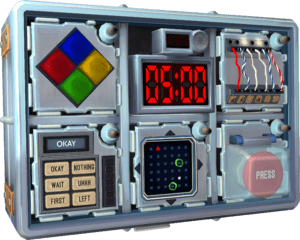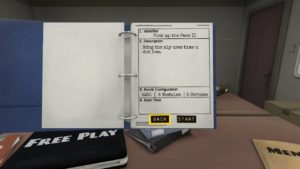
The world is seeing a boom of peaceful games and games that help people relax. It makes sense, the world can be very hectic and fast-paced, and sometimes a game makes for a great way to de-stress. These games are expertly crafted to allow the controls, music, sound effects, and gameplay itself to inspire calmness.
Then there are games like Keep Talking and Nobody Explodes where the only peace you’ll find is in the menu. Have you ever watched a movie where someone who shouldn’t even be near a bomb is forced to defuse it, and they’re on the phone with a specialist that has to walk them through the instructions to do it? That’s Keep Talking and Nobody Explodes in a nutshell. One player is tasked with defusing the bomb, while anyone else around is responsible for talking you through what steps to take to defuse it. The person with their hands on the bomb isn’t allowed to look at the bomb defusal manual, and no one else is allowed to look at the bomb itself. To make matters worse, this isn’t just a matter of cutting wires, there are around a dozen different types of modules in the game and there can be up to eleven modules per bomb! These modules all have numerous solutions, and the only way to figure them out is to relay information back and forth with the rest of the team.

For example, one of the modules you’ll face is a simple wire cutting module, the type of thing you’d see in most movies where cutting the right wire deactivates it. There can be 3-6 wires of varying colors, and deciding which wire to cut can be based upon the total number of wires, how many of a particular color there are, and even the serial number on the bomb. Another module gives you a 6×6 grid with two circles, a triangle and a white light. There are actually invisible lines that create a maze, and you have to navigate the white light to the triangle without touching any of the invisible walls with your team’s help based on where the two circles are. Then there are needy modules: modules that are rather simple to complete but reset themselves every so often as you’re working, and you’ll need to refer back to them whenever they start up again. And if all of that isn’t bad enough you’ve also got an alarm clock in the room for some crazy reason that decides to go off randomly; this won’t hurt you at all, but the noise is annoying and loud enough that you’ll want to put the bomb down long enough to grab the alarm clock and turn it off. And the lights go out every once in a while, preventing you from seeing anything on the bomb that isn’t lit up. In any other game I’d recommend just turning the audio off to battle the alarm clock, but the needy modules make noise when they reactivate and the sound effects are perfectly done all around.
All of this sounds crazy, and it certainly is, but it all works beautifully while playing. Keep Talking and Nobody Explodes is a game that I was very excited to try out, but it’s also a game I was fearful of trying. I’m really shocked at just how much I like it; I ended up playing for almost 4 hours until the Switch battery warning came up and I had to quit. I didn’t even realize so much time had passed! I’m very fortunate to have a co-op partner (my fiancé) whose strength with memory makes up for my incredible inability to remember much of anything at all. The variance in the types of modules means that you can have a team of just one person (like I had) or 500 helping, and if you were a hardcore player you could even split the team into specialists: someone with a great memory, someone who can quickly look at patterns of words, someone who can read instructions quickly, etc.

The manual is available online and can be printed off or viewed on any device, and both forms have negatives and positives. I printed it off for my fiancé to use since our phones are small, but physically flipping pages takes a bit longer since pages stick together. On the other hand, if you have a more than two people playing total, you can take a single physical copy and split it amongst members instead of everyone having their own, so that when whoever is playing the game calls out the next module to defuse the person with the matching instructions can get to it quicker. Just like real life, every second counts, but accuracy is the most important thing of all. Aside from hardcore mode and some of the challenges, you’re given three strikes before the bomb explodes, but each strike also speeds up the timer; one strike is often enough to take you out due to the quicker timer, let alone two, but sometimes having the extra chances comes in really handy if you’re down to just one module and don’t have the time to work out the solution properly.
The game is broken into two modes: free play and a set of specific challenges. Free play allows you to set all sorts of options – your time limit, the total number of modules, whether or not needy modules are allowed and whether you want three strikes or only one – and there’s even an accessibility menu that allows you to exclude up to three types of modules (screw you Morse Code module!). This mode randomly generates a bomb for you so it’s much more replayable, but the challenges are a perfect way to learn how everything works. This mode is where we spent most of our time, and it gives you bombs that become increasingly difficult until you’re sweating so much it’s harder to hold the controller than deactivate the bomb! The levels eased me into the game enough that I learned how to play easily, and they’re varied enough that I never felt bored. By the end of the mode there are specific themes, which range from totally crazy (a bunch of needy modules that barely leave you time to actually defuse anything) to insanely hard (solving a bunch of modules in a tiny amount of time). These levels also display the amount of time remaining after you beat them, so you could presumably replay them (especially the more fun, themed ones!) hoping to beat your best score. The introductory levels and instructions are also replayable anytime in case you haven’t played in a long time or you’re allowing someone new to try out the role of bomb defuser.

Keep Talking and Nobody Explodes is a remarkable co-op party game, and it’s amazing how it allows any number of players to play it together (aside from solo play). Not only can you play with any number of people, you can even play with people over party chat, the phone, Skype, or whatever you’d use for voice chat as only one player is allowed to look at the game screen. It’s an easy recommendation for anyone who loves co-op games or party games, and I can’t wait to see just how ridiculous the game is with a bunch of people trying to work together.
Super Destronaut DX is available for Switch (reviewed), PS4 (PSVR optional), Xbox One, and Steam (Windows, Mac, Linux; HTC Vive or Oculus Rift optional).
I received a free copy of this game in exchange for an honest review.

